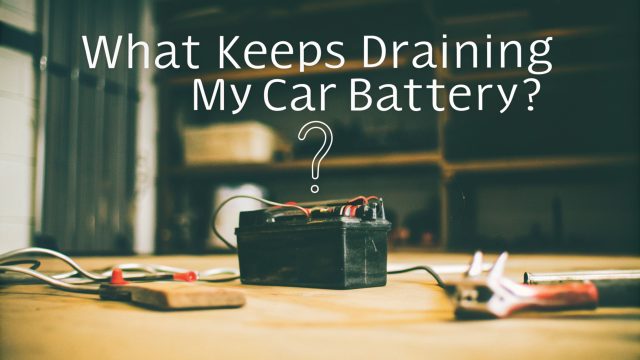Please note that this post may contain affiliate links and any sales made through such links will reward me a small commission – at no extra cost for you..
You’re late for work, coffee in hand, and your car won’t start again. And you’re left wondering: What Keeps Draining My Car Battery?
A drained battery can be puzzling, particularly when things appear a mess. You may have switched off the lights, or the battery might be brand new. What could be the issue?
In this guide, we’ll break down the most common things draining your car battery and show you how to fix them, even if you’re not a mechanic.
Common Causes of Battery Drain
1. Lights Left On:
Sometimes, a light inside your car is on, draining your battery. This can happen when you turn off the car, but the door isn’t closed properly, or a switch is left on. Some new cars have a feature that turns the lights off automatically, but if your car doesn’t, you have to switch them off yourself otherwise, they can drain your battery.
2. Old Battery:
Every part has its limit, After about three to four years, you may notice your car takes longer to start. Especially in cold weather, you may notice your engine starts more slowly, your lights look dimmer, or you need a jumpstart more often. It starts draining faster than it should, so it’s not a small issue. These are the signs your battery should be replaced before it leaves you stuck.
3. Big Temperature Swings:
If your battery is old, your car won’t handle very hot or very cold weather well. In summer, the heat can dry out the battery, and in winter, the cold can slow it down, making it harder to start your car. A new battery can handle these temperatures much better.
4. Quick Drives And Long Breaks:
The battery slowly drains when you only take quick drives, like running to the nearby grocery store. In those short trips, the alternator doesn’t get enough time to fully recharge the battery. Also, if your car sits parked for weeks without being driven, the battery keeps draining even if it’s pretty new.
5. Battery Not Plugged In Right:
The metal connectors on your battery can become loose or dirty over time, especially if you drive on bumpy roads. If they’re not tight or covered in white or greenish powder, your car might not start easily. It also makes it harder for the battery to send power to the car and can even affect your car’s electronics.
In-Depth & Overlooked Battery Drains:
1. Parasitic Battery Drain:
Sometimes, small systems continue running even when the car is off, like a tiny light in the glove box, security systems, USB port, power seats, dashcams, or the clock. To avoid this, double-check that your glove box is fully closed and no lights are left on when you leave your car. Otherwise, you might come back to a dead battery. If you think you’re dealing with a parasitic drain, you can check it yourself by disconnecting the battery, using a multimeter, and looking for a current draw over 50 milliamps. If you find one, start pulling fuses one at a time to figure out which system is causing the issue.
2. Battery Not Getting Charged While Driving:
When you start your car, the battery does the work. The alternator keeps it charged while you drive. If the alternator isn’t working properly, the battery won’t get the power it needs. So even if you were just driving, your car might not start the next time you try. This kind of charging problem can drain your car battery.
3. System Glitch in Car Electronics:
You park your car at night, everything seems fine, but in the morning, the battery is dead. It could be because something is wrong with parts of your car, like the BCM or Engine Control Unit, which control electrical systems. These systems act like the car’s brain, and if they glitch or don’t shut down properly, they can slowly drain your battery without you knowing.
4. Extra Stuff You Installed in Your Car
Let’s say you leave a phone charger plugged in all the time, even when the car is off it could leave you with a dead battery by morning. Things that didn’t come with your car, like a custom sound system, dash cam, or extra lights, can also keep pulling power from your battery if they’re not wired properly.
5. Bad Fuses or Ground Wires
It happens when there’s an issue with the electrical connections in your car. Fuses protect your car’s electrical system from getting too much power. If the fuse is broken, it can stop parts of your car from getting power. Ground wires are the pathways that complete the electricity flow. If these wires get disconnected, your car’s electrical systems may not work properly, which can drain your battery.
“Did you know that a car battery typically lasts 3-5 years? However, about 25% of drivers experience battery failure before it reaches that age, often due to factors like electrical drain and extreme weather.”
Tips to Keep Your Battery Healthy
Use a Smart Battery Charger
A smart charger keeps your battery healthy by giving it exactly the power it needs. It automatically stops when the battery is full, so it doesn’t overcharge. It’s perfect if your car stays parked for a long time.
Get Your Electrical System Tested Annually
Once a year, have a mechanic check your battery and electrical system. This helps find small problems early before they leave you stuck with a dead battery.
Clean your terminals
Clean your battery terminals regularly to make sure the battery can send power properly. The most common way to clean them is by using a mixture of baking soda and water.
Protect the Battery with an Insulation Kit
You can use a battery insulation kit in very hot or cold weather to protect your battery. It helps the battery last longer and work better.
Double-Check Lights
Before leaving your car, always check that all the lights are off. This helps prevent the battery from draining overnight.
Conclusion
Taking care of your battery can save you from unexpected breakdowns. By understanding the common causes of battery drain and following these prevention tips, you can keep your battery healthy for longer. A little attention and regular checks will help keep your car running smoothly. Otherwise keep on thinking What Keeps Draining My Car Battery?

